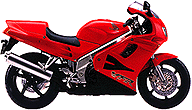

This article was originally posted by David on the VFR List in response to a Lister's question. David has graciously allowed me to post it here. This question is asked fairly often and should be of interest to other VFR owners.
1990-93 - A Major UpgradeNew frame (even different from the RC30). New racier bodywork with the turn indicators as part of the bodywork, except U.S. models which got Department of Transportation (D.O.T.) approved dorky rear turn signals attached to the truly ugly, 3 foot long "Euro" rear fender.
Seat extends well into the tank and bodywork and the riding position was made a bit more prone. Dual headlight bulbs (45/45 watt) with a different pattern mounting tabs from a D.O.T. A H-4 bulb in a single lens (fairing made the lens look like a double lens); 4/2/1 right side exhaust that pivoted out of the way for rear wheel removal; engine changed back to a 180° crank; "Elf Designed" PRO-ARM (single sided) rear swingarm; 3.5x17 inch front and 5.5x17 inch rear wheel held in place by 4 nuts; 41mm forks are new and much improved over the 1986-87 models. Newest Nissin 4 piston front brakes are gold but the rear brake is painted black. Pillion rider grab rails fold into bodywork out of sight or can be easily removed. Center stand and seat cowl are now options in U.S. market, right side heat bath is not an option, it is here and it is hot! This is virtually the only complaint of the bike, that and most would rather have the RC30 style (left side) exhaust, rather than the "novel" right side exhaust with a pivot for swinging out of the way for rear wheel service.
1994-97 Overview
Honda claims to have made some "300" changes to our beloved VFR. The new bodywork is "Styled" after the NR750 or Honda's Oval Piston Wonder bike. The U.S. DOT has "seen the light" and mounted the rear turn signals where God (or at least Honda) intended them to be ... in the bodywork. Red is BACK on U.S. models, although this time it has a pearl finish in the clear coat (1990-91 VFRs were solid red). Europe gets Red, Black or Turquoise.
Personally, I wish that Honda would have went further with the NR style and given the VFR simular tank and tail pieces with the exhaust under the seat, ala NR and Ducati 916. Everything on the bike was looked at to reduce weight, even the rear wheel went down to a 5.0 X 17 inch (from the previous 5.5 wide hoop). Depending on who you talk to, the bike dropped 16 to 30 lbs. According to the Honda propoganda sheet, the front wheel is 600 grams and the rear 800 grams lighter. NOTE: The smaller rim means you cannot or should not use a 180 rear tire, stay with a 170.
The new, lighter frame holds revised cartridge forks which are 600 grams lighter yet stronger because of more overlap and a new shock. The "Elf Designed" PRO-ARM (single sided) rear swingarm is both stronger and 200 grams lighter. The new O-ring chain is even lighter by 100 grams! Other items specifically mentioned are the foot pegs & brackets, handle bars, side & center stands, faring, passenger grab rails and exhaust system. The bike does feel lighter than the 1990-93 models The cockpit looks different as well with a white faced tachometer. Less heat hits the rider's right leg which is another good point. The seat does not wrap around the tank anymore. The center stand is now standard in U.S. and Europe. The engine is essentially the same but sports smaller 34mm carbs and a new design 4/2/1 exhaust mostly for better throttle response - who knew it needed it?
The 1994+ VFR was nice but I found it not worth the price of a new one and kept my 1991. IMHO - In the real world the rider was the difference between the two (2) models. I also liked the looks of the previous model better.
1998-99 VFR800FI Overview
"New from the ground up" as the propaganda literature would tell you. It does however have many "firsts" and "new" associated with it. Starting with the high-pressure-formed aluminum/ceramic/graphite composite cylinder sleeves. These are lighter than steel sleeves, better wear resistance and better heat dissipation qualities.
It also features precision programmed electronic fuel injection instead of carburation. It uses an electronic control unit [computer] to meter fuel delivery and ignition control on each cylinder. Chassis components: Pro Arm single-sided cast aluminum swingarm is now mounted to the engine. Honda claims it provides better rear-wheel accessibility with more torsional rigidity than the previous model. Dual, side mounted radiators are also used for a shorter wheel base.
Integrated Link Braking System. This is different from the systems offered on the GoldWing and CBRXX models, but there is still controversy surrounding its use. Most people or Americans anyway, consider it an insult to have someone else tell them what or how to do it. We hate it when "Big Brother" passes laws to protect us from ourselves such as seat belts and helmet laws. Most who have actually ridden the VFR800FI either don't really notice it or they like the squat characteristics while braking for turns - less front-end dive is the result. The 800 uses a 5.5 inch rear rim and comes with a 180 rear tire.
Except for some people complaining of an "off-idle" surge, the new bike is a better bike both in engine and handling compared to the earlier models.
Hope this helps.
David M. Matthew
'91 VFR750F (RC36)
